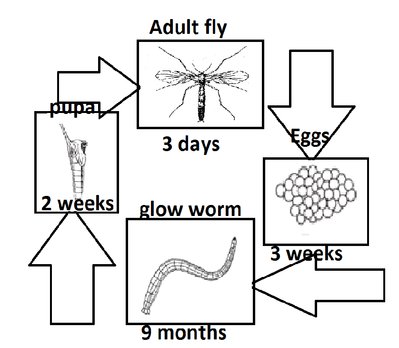
When we talk about glow worms, we’re often referring to species like Lampyridae, which includes fireflies. They go through a remarkable transformation from egg to adult, much like a butterfly emerging from its cocoon. Understanding this lifecycle not only helps us appreciate these tiny luminaries but also sheds light on the delicate ecosystems they inhabit. So, let’s dive into this glowing journey!
The Egg Stage: Tiny Beginnings
The lifecycle of a glow worm kicks off when a female lays her eggs. These eggs are incredibly small, often no bigger than a grain of sand. They’re usually laid in moist environments, such as in the soil or under leaves in humid areas. One might think of them like little surprises, waiting for the right moment to burst into life.
After a few weeks, the eggs hatch into tiny larvae. At this stage, they might seem innocuous, but these little creatures are already equipped with the ability to glow. That glow is essential for attracting prey, especially small insects. Imagine being born with a flashlight to help you find food—pretty cool, right?
During this initial phase, environmental factors like humidity and temperature play a crucial role. If conditions are too dry, many of these tiny eggs won’t survive. This vulnerability highlights just how important it is for glow worms to thrive in their specific habitats.
The Larval Stage: A Journey of Growth
Once the eggs hatch, we enter the larval stage, which is when the magic truly begins. Glow worm larvae are voracious eaters, spending most of their days hunting for food. They weave silk threads to create webs that trap unsuspecting insects, sort of like a spider. When a hapless bug gets caught, the glow worm pulls it in, feeding on its nutrients.
During this stage, glow worms can grow quite large, sometimes reaching up to a few centimeters in length. It’s fascinating how these larvae can adjust their glow based on need; if food is scarce, they conserve energy and may glow less. This adaptability is essential for survival.
The glow itself comes from a process called bioluminescence. It’s a chemical reaction within their bodies, and it’s not just for show. The light helps lure in prey, ensuring the larvae get enough food to support their growth. You might say it’s nature’s way of making dinner a bit more appealing!
Pupation: The Transformation Process
After spending several months as larvae—sometimes even up to a year—glow worms enter the pupal stage. This part of their lifecycle is a remarkable transformation, akin to a caterpillar turning into a butterfly. The glow worm burrows into the ground or finds a safe spot under logs or rocks, where it can metamorphose in peace.
During pupation, the glow worm’s body undergoes a series of profound changes. Its soft, squishy body hardens into the form of an adult beetle. This transformation is critical; it prepares the glow worm to become a fascinating adult that’s capable of reproducing.
It’s worth noting that during this stage, glow worms don’t glow at all. Instead, they focus all their energy on developing those important adult features. It’s like they’re in a cozy spa, getting ready for their big reveal!
Finally, we reach the adult stage of the glow worm’s lifecycle. Once the transformation is complete, they emerge as beautiful beetles. Interestingly, many adults often lose the ability to glow, and some even lack functional mouths, meaning they don’t eat at all! Their entire purpose during this stage is to mate and lay eggs, ensuring the cycle continues.
Adult glow worms tend to have a very short lifespan—around a few weeks. During this time, the females emit a series of alluring light signals to attract males. Think of it as a glow-in-the-dark dance party, where the brightest signals win the attention of a mate!
The adult stage is where survival instincts kick in. Once they mate, females search for the perfect, damp place to lay their eggs, thus beginning the lifecycle anew. This cycle connects generations of glow worms, and it’s fascinating to think about how each new generation contributes to the fragile ecosystem they inhabit.
The Importance of Glow Worms in Ecosystems
Understanding the lifecycle of glow worms goes beyond mere curiosity. These unique creatures play a vital role in their ecosystems. As both predators and prey, their presence indicates a healthy environment. They help control insect populations and are a food source for various animals, including birds and bats.
Moreover, glow worms contribute to the beauty of nature. Their glowing presence can be a draw for eco-tourism, bringing awareness and funding to conservation efforts. Protecting their habitats means preserving their lifecycle and the magic they bring to our nights.
In many parts of the world, glow worms serve as key players in the local ecosystem. The balance they maintain can influence the health of entire forests or caves. So, understanding and respecting their lifecycle is essential if we want to protect not only glow worms but the ecosystems in which they thrive.
From tiny eggs to radiant adults, the lifecycle of glow worms is a captivating journey that showcases nature’s wonders. These little creatures remind us of the delicate balance within ecosystems and the beauty that lies in every corner of our world.
As we continue to delve into the mysteries of nature, it’s essential to appreciate the intricate connections that make up our environment. Understanding the glow worm lifecycle not only enriches our knowledge but encourages us to protect these enchanting lights for generations to come. So, the next time you see a glow worm twinkling in the twilight, remember the fascinating journey it took to get there!
